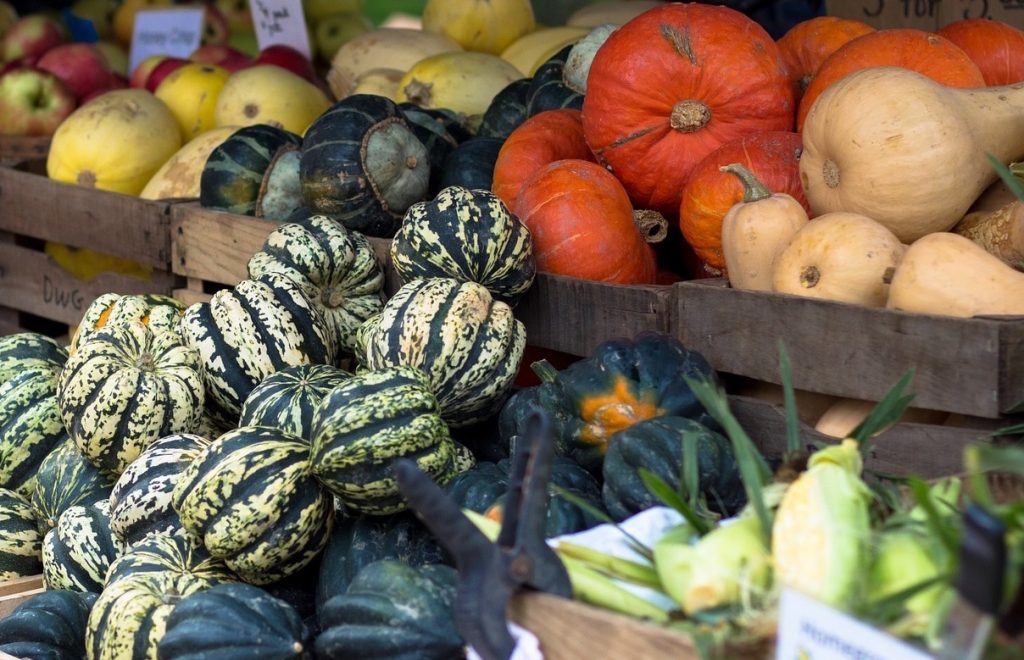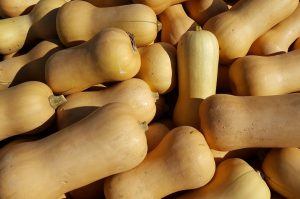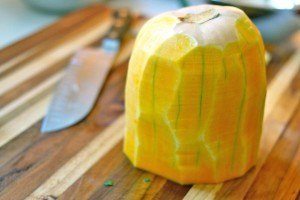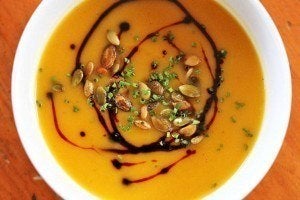
Pumpkins may attract much attention as an official sign of cooler weather, but they are just one of dozens of seasonal squash varieties in the Cucurbitaceae (gourd) family. “Winter” squashes are uniquely beautiful with ribbed or bumpy skins, irregular shapes, and vibrant colors ranging from yellow to orange to dark green or even multi-toned. Sometimes displayed as seasonal table decorations, they are best appreciated when featured as a star ingredient in a wide range of recipes.
Compared to their summertime cousins, winter squashes have a denser texture and flavor with firm flesh that holds up well in hearty soups, stews, casseroles, breads, and desserts. For the quickest enjoyment, the flesh may be scooped and eaten straight from its shell after cooking. Their seeds are also edible and nutritious.
The most common varieties found in supermarkets include butternut, delicata, spaghetti, kabocha, hubbard, acorn, sweet dumpling, and sugar pumpkins (these are firmer, sweeter, and less stringy than the larger carving pumpkins).
Source Of
- Carotenoids: beta carotene (a precursor to vitamin A), lutein, zeaxanthin
- Protein
- Vitamin C
- Vitamin B6
- Fiber
- Magnesium
- Potassium
Winter Squash and Health
Generally, a diet rich in vegetables and fruits can lower blood pressure, reduce risk of heart disease and stroke, prevent some types of cancer, lower risk of eye and digestive problems, and have a positive effect upon blood sugar which can help keep appetite in check. And while several nutrients in squash like the carotenoids, vitamin C, polysaccharide fibers, and minerals such as potassium and magnesium have been researched individually for their role in health and chronic disease prevention, there is a lack of epidemiological studies or controlled trials looking at specific health benefits of winter squash. Historically, winter squash has been used in some cultures as a medicinal plant to treat diabetes, high blood pressure, cancer, high cholesterol, and inflammation. [1]
- Diabetes: Squash is a dense, filling food despite being fairly low in calories (45-90 calories per cup cooked, depending on type) with a low glycemic index and load. Butternut squash, for example, has almost half the amount of carbohydrate of a sweet potato. Squash also contains polysaccharides, a type of indigestible fiber that can prevent blood sugar from rising after eating, as shown in animal studies. The protein and unsaturated oils from the seeds may also have a moderating effect on blood sugar. [1]
- Cancer: Certain compounds in squash like beta-carotene and lutein are classified as flavonoids that may help to protect human cells from the damaging effects of oxygen. Flavonoids have been researched extensively for their possible role in affecting or inhibiting cancer cell growth. [2]
- Heart health: Winter squash is rich in potassium (about 500 mg in 1 cup of cooked butternut or acorn squash), which can help to counteract the deleterious effects of sodium on blood pressure. Decreased cholesterol was observed when giving pumpkin polysaccharides to healthy and diabetic mice. [1]

Select
Choose squash that has a firm exterior and no soft spots, or cracks. Unlike some fruits that develop a softer exterior as they ripen, the rind of winter squashes becomes even firmer as they mature. The skin should be matte and hard to pierce with your fingernail, not shiny and soft, which would indicate an unripe squash. A squash with soft areas, or a moldy stem is well past its prime. You can also use the tap test. Knock on the skin with your knuckle: if it sounds hollow, it is ripe; if it sounds dull, the squash may either be unripe or spoiled.
If you have purchased an unripe squash, place in a warm sunny spot. Plenty of sunlight is key for the squash to ripen. If it is mature and ripe, store the squash in a cool dark area in your kitchen but do not refrigerate. Although some squash may last several months in the right storage conditions, it is recommended to use them within one month for best flavor.
Prepare
If you are new to cooking squash and feel the thick surface, you might wonder “How do I get into it?” The hard rinds of winter squash allow them to be stored for up to several months, but they also present a challenge when attempting to safely slice with a knife.
Rinse winter squash under cold running water before cutting. Use a vegetable brush if needed to remove any debris. After drying, you have a few options depending on the type:
- A vegetable peeler is a good tool to remove the skin from butternut squash or sugar pumpkins, but microwaving first can make it easier. Pierce the skin of the squash in several places with a knife. Microwave the squash for about 3-4 minutes (or longer if a very large squash). This helps to soften the skin for more effortless peeling.
- Eat the skins of thin-skinned squash like delicata. Slice in half lengthwise, scoop out the seeds with a spoon or ice cream scoop, and roast. Or you may slice into smaller strips before cooking.
- If you wish to use the squash as a “bowl” but the skin is too thick to easily slice in half, such as with acorn or spaghetti squash, make a few knife slits around the squash. Microwave for about 5 minutes, cool, and then slice in half. It is now ready for cooking.

Make
Squash is versatile and retains its flavor whether roasting, boiling, steaming, microwaving, or simmering in a stew. Dry heat as with roasting helps to caramelize the natural sugars in the squash. The dense textures of all squash types will add heartiness with whatever cooking method is used.
Choose from the following options:
- Shape: Whole, halved into two “bowls” and stuffed, long slices, cubes, smaller dice, or mashed.
- Cooking Method:
- Roast: After softening the skin using the microwave method above, slice squash in half, remove the seeds and stringy material, and place cut-side up on baking sheet. Rub with oil and season with herbs and spices as desired. Flip the squash cut-side down and roast in a 400 F preheated oven for 25-45 minutes (depending on the size) or until flesh is fork tender. The skin should be soft and make an indent if you press your finger into it. Remove from oven and cool for 10 minutes before handling.
- If cooking whole, place washed squash on ungreased baking sheet and insert a few knife pricks throughout. Roast for 45-60 minutes, depending on size, at 350 F or until skin is very tender and easy to prick with a fork. Cool for a few minutes and then cut squash in half carefully, as steam may escape. Remove seeds with a spoon or scoop.
- Boiled: Remove the skin from the squash and cut in half. Remove the seeds and stringy material (save these to roast separately later or to make a stock). Cut the squash into 1-inch chunks and place in a large saucepan, adding enough water to cover the squash. Bring to a gentle boil, cover, and simmer until the flesh is desired tenderness, about 10-15 minutes. To steam, follow the above directions but place squash in a steamer basket.
- Microwaved: Remove the skin and cut in half, removing the seeds. Place on microwave-safe plate cut-side down and heat on high for 5-10 minutes depending on size, or until tender. Let stand for a few minutes before handling.
- Stewed: Remove the skin and seeds and slice into uniform small chunks. Mix into soups, stews, or casseroles at the beginning of the cooking time.
- Roast: After softening the skin using the microwave method above, slice squash in half, remove the seeds and stringy material, and place cut-side up on baking sheet. Rub with oil and season with herbs and spices as desired. Flip the squash cut-side down and roast in a 400 F preheated oven for 25-45 minutes (depending on the size) or until flesh is fork tender. The skin should be soft and make an indent if you press your finger into it. Remove from oven and cool for 10 minutes before handling.
- Serve:
- Mashed: After removing the seeds and skin of a cooked squash, mash or puree the flesh with 1-3 tablespoons of oil (more if a larger squash) and a pinch of salt or spices as desired (try ground cumin, chili powder, black pepper, coriander, oregano, sage, ginger, or cinnamon).
- Stuffed: Prepare a “stuffing” by mixing together any cooked grain (e.g., brown rice, quinoa, farro, bulgur), chopped nuts, dried fruit, and herbs. Using the roasting cooking method above with two squash halves, first make a small cut on the bottom of each half (to make a sturdy flat surface) and then roast the squash. Halfway through the cook time, remove the squash from the oven and fill the center of each half with stuffing. Continue cooking until squash flesh is tender.
Spaghetti: After roasting spaghetti squash, allow to cool for a few minutes. Using a fork, scrape the flesh repeatedly to create noodles. Place noodles into a bowl and toss with your favorite pasta sauce, or mix with a drizzle of olive oil and chopped herbs. - Burgers: Use a food processor or wooden spoon to roughly mash the squash and then add as a filling to veggie burgers or meatless meatballs.
More recipe ideas and serving suggestions featuring winter squash:
Did You Know?
- Squash seeds make a delicious snack. Wash and dry the seeds with a paper towel. Don’t worry about removing all the stringy material as these will shrivel when roasted. Spread in a single layer on a baking sheet lined with parchment paper and drizzle with oil; mix the oil into the seeds with your hands to coat well. Sprinkle a pinch of salt or any other herbs or seasonings desired (if you prefer sweeter, try cinnamon, pumpkin pie spice, or nutmeg). Roast at 275-300 degrees F for 20-25 minutes or until seeds start to brown. It is preferred to cook seeds at a lower temperature in order to prevent the breakdown of the unsaturated fats.
- Which squash skins can you eat? All winter squash skin is technically edible but the thinner the skin, the more pleasant the texture is, such as with delicata, acorn, and sweet dumpling. Thicker skins are usually too tough to chew and enjoy, so they might be saved instead to make a vegetable stock.
- Winter squash is technically classified as a fruit, but for culinary purposes is treated like a vegetable.


